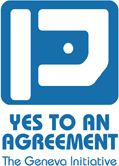On August 15–16, we held a two-day seminar for the key activists from the Pink Front, one of the leading organizations in the Israeli grassroots movement for protection of democratic values and institutions. The purpose of the seminar was to provide knowledge and tools to Pink Front members so they can integrate the issue of the two-state solution into the organization’s agenda.
We launched the seminar with a session titled “How do you respond to those who are skeptical?” in which Yariv Oppenheimer (Geneva Initiative) and Maya Ilany (Molad Institute) addressed the tough questions raised in Israeli society and media after October 7th: Is a Palestinian state a prize for terror? What are the Israeli and Palestinian requirements, obstacles and possibilities related to evacuation of settlements in the framework of a negotiated agreement? How do we respond to the narrative spin surrounding the disengagement from Gaza? And much more.
We then continued to an inspiring meeting with Hiba Qasas, originally from Nablus and currently the Executive Director of the international peace organization Principles for Peace, and formerly a senior official at the UN. With Hiba, we learned about the lessons she drew from the ways in which civil society contributed to peace efforts in other global conflicts, and how to influence policy from grassroots and other organizing movements. Hiba leads the Uniting for a Shared Future coalition, which brings together hundreds of Israelis and Palestinians working jointly to advance a regional political comprehensive framework for conflict resolution.
From there, we moved on to a lecture by Dr. Galit Deshe, an expert on the conflict and peace process in Northern Ireland. We discussed the roles of art, culture, and women’s leadership in reaching an agreement to end the Troubles. One of the most significant points was hearing how women from civil society on both sides of the conflict refused to compromise on their place at the negotiation table. The art that continues to serve as symbols of reconciliation provided us with great inspiration for the effort to normalize the need for peace in the public sphere.
Later, we met with Dr. Khalil Shikaki, one of the foremost Palestinian pollsters in the field, who presented up-to-date public opinion data from Palestinian and Israeli society. One of the most important insights we took from his lecture was how different incentives can substantially increase public support for the two-state solution—teaching us that public opinion is flexible and can be transformed under the right conditions from a barrier to a pathway towards political progress between Israelis and Palestinians.
We closed the first day with Maj. Gen. (res.) Nimrod Shefer, who offered an in-depth overview of what “security doctrine” means and how to link security needs with political agreements. We learned that there is no such thing as security in an endless war; agreements such as those between Israel, Egypt and Jordan are essential to ensure that we can live within agreed borders and overcome points of tension with diplomacy. We also spoke about the need for courageous leadership that will advance an uncompromising call to return to the path of the two-state solution.
On the second day of the seminar, the group attended a geopolitical and narrative tour of East Jerusalem, where we engaged with the issue of Jerusalem as a microcosm of the entire conflict. We learned about possible solutions, about the holy sites and the Temple Mount/Haram al-Sharif, and about the lives of Palestinians in East Jerusalem—and of course, how all of this connects to the Israeli government’s historic policies on borders, status, land, and holy sites over time. After the tour, we met with young Palestinian Jerusalemites who shared their personal experiences since the start of the war, and their vision of how Israelis and Palestinians can work together toward a better and safer future for all.

